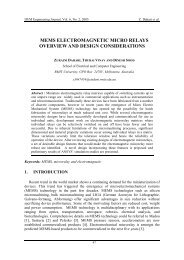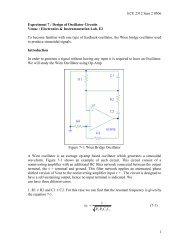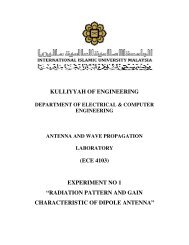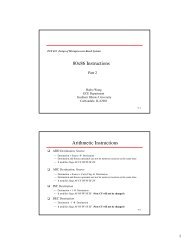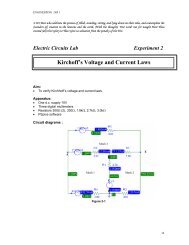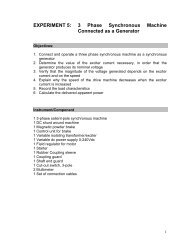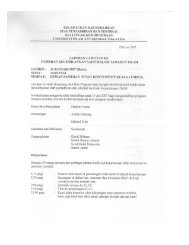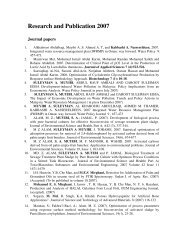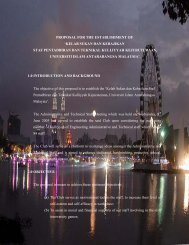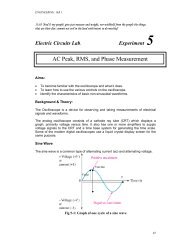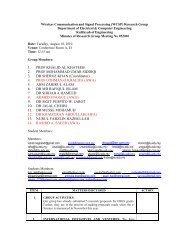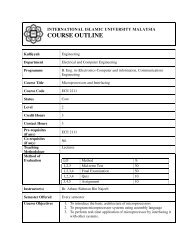8088/8086 Instruction I
8088/8086 Instruction I
8088/8086 Instruction I
You also want an ePaper? Increase the reach of your titles
YUMPU automatically turns print PDFs into web optimized ePapers that Google loves.
ECE 424 Design of Microprocessor-Based Systems80x86 <strong>Instruction</strong>sPart 1Haibo WangECE DepartmentSouthern Illinois UniversityCarbondale, IL 629018-1
<strong>Instruction</strong> Types Data transfer instructions String instructions Arithmetic instructions Bit manipulation instructions Loop and jump instructions Subroutine and interrupt instructions Processor control instructionsAn excellent website about 80x86 instruction set: http://www.penguin.cz/~literakl/intel/intel.htmlAnother good reference is in the tutorial of <strong>8086</strong> emulator8-2
Addressing ModesAddressing Modes Immediate addressing Register addressing Direct addressing Register Indirect addressing Based addressing Indexed addressing Based indexed addressing Based indexed with displacement addressingExamplesMOV AL, 12HMOV AL, BLMOV [500H], ALMOV DL, [SI]MOV AX, [BX+4]MOV [DI-8], BLMOV [BP+SI], AHMOV CL, [BX+DI+2]Exceptions String addressing Port addressing (e.g. IN AL, 79H)8-3
Flag Register Flag register contains information reflecting the current status of amicroprocessor. It also contains information which controls theoperation of the microprocessor.150⎯ NT IOPL OF DF IF TF SF ZF ⎯ AF ⎯ PF ⎯ CF Control Flags Status FlagsIF:DF:TF:Interrupt enable flagDirection flagTrap flagCF:PF:AF:ZF:SF:OF:NT:IOPL:Carry flagParity flagAuxiliary carry flagZero flagSign flagOverflow flagNested task flagInput/output privilege level8-4
Flags Commonly Tested During the Execution of<strong>Instruction</strong>s There are five flag bits that are commonly tested during the executionof instructions⎯ Sign Flag (Bit 7), SF: 0 for positive number and 1 for negative number⎯ Zero Flag (Bit 6), ZF: If the ALU output is 0, this bit is set (1); otherwise,it is 0⎯ Carry Flag (Bit 0), CF: It contains the carry generated during the execution⎯ Auxiliary Carry, AF: Depending on the width of ALU inputs, this flag(Bit 4) bit contains the carry generated at bit 3 (or, 7, 15)of the <strong>8088</strong> ALU⎯ Parity Flag (bit2), PF: It is set (1) if the output of the ALU has even numberof ones; otherwise it is zero8-5
Data Transfer <strong>Instruction</strong>sMOV Destination, Source— Move data from source to destination; e.g. MOV [DI+100H], AH— It does not modify flags For 80x86 family, directly moving data from one memory location toanother memory location is not allowedMOV [SI], [5000H] When the size of data is not clear, assembler directives are usedMOV [SI], 0 BYTE PTR WORD PTR DWORD PTRMOV BYTE PTR [SI], 12HMOV WORD PTR [SI], 12HMOV DWORD PTR [SI], 12H You can not move an immediate data to segment register by MOVMOV DS, 1234H8-6
What is a Stack ?<strong>Instruction</strong>s for Stack Operations— A stack is a collection of memory locations. It always follows the rule oflast-in-firs-out— Generally, SS and SP are used to trace where is the latest date written into stackPUSH Source— Push data (word) onto stack— It does not modify flags— For Example: PUSH AX (assume ax=1234H, SS=1000H, SP=2000Hbefore PUSH AX)1000:1FFD??1000:1FFD??1000:1FFE??SS:SP1000:1FFE341000:1FFF??1000:1FFF12SS:SP1000:2000??1000:2000??12 34Before PUSH AX, SP = 2000HAfter PUSH AX, SP = 1FFEHAX Decrementing the stack pointer during a push is a standard way of implementing stacks in hardware8-7
<strong>Instruction</strong>s for Stack Operations PUSHF— Push the values of the flag register onto stack— It does not modify flagsPOP Destination— Pop word off stack— It does not modify flags— For example: POP AX1000:1FFD??1000:1FFD??SP1000:1FFE341000:1FFE341000:1FFF121000:1FFF121000:2000ECSP1000:2000EC12 34Before POP, SP = 1FFEHAfter POP AX, SP = 2000HAX POPF— Pop word from the stack to the flag register— It modifies all flags8-8
Data Transfer <strong>Instruction</strong>s SAHF— Store data in AH to the low 8 bits of the flag register— It modifies flags: AF, CF, PF, SF, ZF LAHF— Copies bits 0-7 of the flags register into AH— It does not modify flags LDS Destination Source— Load 4-byte data (pointer) in memory to two 16-bit registers— Source operand gives the memory location— The first two bytes are copied to the register specified in the destination operand;the second two bytes are copied to register DS— It does not modify flags LES Destination Source— It is identical to LDS except that the second two bytes are copied to ES— It does not modify flags8-9
LEA Destination SourceData Transfer <strong>Instruction</strong>s— Transfers the offset address of source (must be a memory location) to thedestination register— It does not modify flags XCHG Destination Source— It exchanges the content of destination and source— One operand must be a microprocessor register, the other one can be a registeror a memory location— It does not modify flags XLAT— Replace the data in AL with a data in a user defined look-up table— BX stores the beginning address of the table— At the beginning of the execution, the number in AL is used as theindex of the look-up table— It does not modify flags8-10
String <strong>Instruction</strong>s String is a collection of bytes, words, or long-words that can be up to 64KBin length String instructions can have at most two operands. One is referred to as sourcestring and the other one is called destination string— Source string must locate in Data Segment and SI register points to the currentelement of the source string— Destination string must locate in Extra Segment and DI register points to the currentelement of the destination stringDS : SI0510:00000510:00010510:00020510:00030510:00040510:00050510:000653484F50504552Source StringSHOPPERES : DI02A8:200002A8:200102A8:200202A8:200302A8:200402A8:200502A8:200653484F5050494ESHOPPINDestination String8-11
REP String <strong>Instruction</strong>Repeat Prefix <strong>Instruction</strong>s— The prefix instruction makes the microprocessor repeatedly execute the string instructionuntil CX decrements to 0 (During the execution, CX is decreased by one when the stringinstruction is executed one time).— For Example:MOV CX, 5REP MOVSBBy the above two instructions, the microprocessor will execute MOVSB 5 times.— Execution flow of REP MOVSB::While (CX!=0){CX = CX –1;MOVSB;}ORCheck_CX: If CX!=0 ThenCX = CX –1;MOVSB;goto Check_CX;end if8-12
REPZ String <strong>Instruction</strong>Repeat Prefix <strong>Instruction</strong>s— Repeat the execution of the string instruction until CX=0 or zero flag is clear REPNZ String <strong>Instruction</strong>— Repeat the execution of the string instruction until CX=0 or zero flag is set REPE String <strong>Instruction</strong>— Repeat the execution of the string instruction until CX=0 or zero flag is clear REPNE String <strong>Instruction</strong>— Repeat the execution of the string instruction until CX=0 or zero flag is set8-13
Direction Flag Direction Flag (DF) is used to control the way SI and DI are adjusted during theexecution of a string instruction— DF=0, SI and DI will auto-increment during the execution; otherwise, SI and DIauto-decrement— <strong>Instruction</strong> to set DF: STD; <strong>Instruction</strong> to clear DF: CLD— Example:CLDMOV CX, 5REP MOVSBAt the beginning of execution,DS=0510H and SI=0000HDS : SI0510:00000510:00010510:00020510:00030510:00040510:00050510:000653484F50504552SHOPPERSI CX=5SI CX=4SI CX=3SI CX=2SI CX=1SI CX=0Source String8-14
String <strong>Instruction</strong>s MOVSB (MOVSW)— Move byte (word) at memory location DS:SI to memory location ES:DI andupdate SI and DI according to DF and the width of the data being transferred— It does not modify flags—Example:MOV AX, 0510HMOV DS, AXMOV SI, 0MOV AX, 0300HMOV ES, AXMOV DI, 100HCLDMOV CX, 5REP MOVSBDS : SI0510:00000510:00010510:00020510:00030510:00040510:00050510:000653484F50504552Source StringSHOPPERES : DI0300:0100Destination String8-15
String <strong>Instruction</strong>s CMPSB (CMPSW)— Compare bytes (words) at memory locations DS:SI and ES:DI;update SI and DI according to DF and the width of the data being compared— It modifies flags—Example:Assume: ES = 02A8HDI = 2000HDS = 0510HSI = 0000HCLDMOV CX, 9REPZ CMPSBWhat’s the values of CX afterThe execution?DS : SI0510:00000510:00010510:00020510:00030510:00040510:00050510:000653484F50504552Source StringSHOPPERES : DI02A8:200002A8:200102A8:200202A8:200302A8:200402A8:200502A8:200653484F5050494ESHOPPDestination StringIN8-16
String <strong>Instruction</strong>s SCASB (SCASW)— Move byte (word) in AL (AX) and at memory location ES:DI;update DI according to DF and the width of the data being compared— It modifies flags LODSB (LODSW)— Load byte (word) at memory location DS:SI to AL (AX);update SI according to DF and the width of the data being transferred— It does not modify flags STOSB (STOSW)— Store byte (word) at in AL (AX) to memory location ES:DI;update DI according to DF and the width of the data being transferred— It does not modify flags8-17



